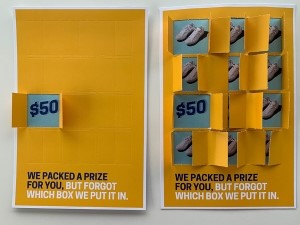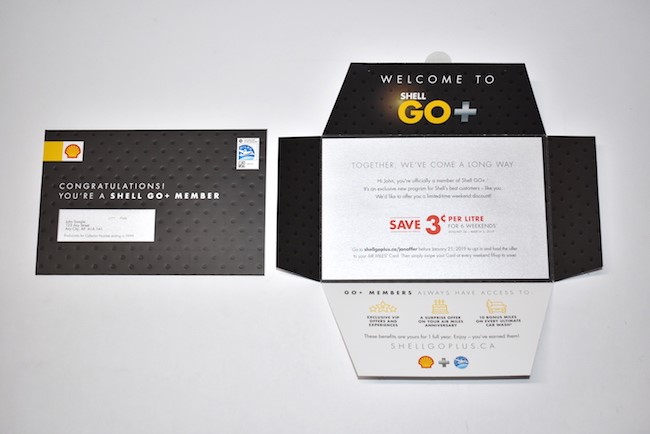Smart Mailing Guide
DESIGNING MACHINEABLE MAIL – STANDARD ITEMS
Craft a more impactful and effective direct mail campaign with these three guidelines
October 28, 2019
By Canada Post

Burke Group recently produced 1,000 advent-style mail pieces for Epcor’s new customer promotion. Featuring 12 windows – with one hiding a $50 account credit – the piece was printed CMYK 4/4 on a Heidelberg 8-colour low energy UV press, 2-up CITO Rotary Chem Mill Die on 80-lb Lynx Opaque Ultra Smooth Cover. Creative Manager Tyson Dueck says the challenge was making a die that perfs the windows and scores the hinges while maintaining structural integrity to avoid rips. Partners for the project include DDB (agency).
Whether the goal is to find new customers, drive more sales
or announce an event, a well-timed piece of direct mail (DM), sent to the right
audience at the right time, is one of the best ways to get results. But how do
you create a piece that maximizes those results? Start with these three rules.
1. Know the 40-40-20 rule
This guideline breaks down which direct mail elements marketers should
emphasize. Specifically, it says that 40 percent of your efforts should be
devoted to your audience, 40 percent to the offer, and 20 percent to creative.
That means targeting the right people (your audience) should be a priority. Use
demographics, psychographics or location-based targeting to hone in on
potential customers. The key is to deliver a message that’s tailor-made for
your particular audience.
Your offer is equally important, so make it compelling and relevant to your
audience. Tracking mechanisms – a phone number, URL or coupon code – help
determine an offer’s success. They also let you calculate the return on
investment on your campaign.
While audience and offer are both top priorities, don’t neglect the creative —
it’s critical to the success of the campaign too. Do the words and images
convey the message you want to send? Does the design encourage interaction and
inspire action? It needs to be strategically designed to get results.
2. Use formatting to your advantage
When it comes to direct mail shape and size, marketers have many choices. Each
format has features and benefits that could work for you, depending on your
particular campaign.
Self-mailers
• Self-mailers, including postcards, are one of the most cost-effective forms
of DM. There’s no need for an envelope, since the customer address is printed
directly on the piece.
• The creative can be produced in many shapes. A pizza shop could print a
paper “slice” announcing a weekly special. A real estate brokerage might send
out a notice in the shape of a house. A moving company might develop a DM in
the shape of a truck. With self-mailers, that level of customization is easy.
• Self-mailers are good for simple messages. Use them to notify existing
customers about upcoming sales and promotions.
• Self-mailers stand out in the mailbox — the message gets seen quickly since
people don’t have to open an envelope to read it.
• You need to choose durable card stock, but your self-mailer doesn’t have to
be a postcard, it can have multiple folding panes.

The Air Miles Shell GO direct mail campaign,
created and printed by TC Transcontinental, targeted Shell’s best customers to
join the Shell GO+ program. The carrier was printed 4/4 on a Heidelberg XL +
soft touch AQ + spot gloss UV on 80-lb silk cover stock, offline deboss and
die-cut, while the letter was printed 4/4 variable on an HP Indigo. A matte
silver foil sticker seal added to the invitation-type look.
Outer envelope and letter• Include your pitch, announcement, offer or other message on the
letter. A #10 envelope has a clear pane, so the name and address can be seen,
which makes it ideal for personalizing your offer.
• The outside of the envelope provides more real estate for your message.
Adding copy to this area also creates visual interest and will help your direct
mail stand out.
Catalogues
• Catalogues and mini-catalogues allow you to include more information than
other direct mail options. Use them to tell your brand story and to describe
products in detail.
• If you incorporate aspirational photography and inspiring content, a
catalogue can help re-engage lapsed customers and increase order sizes. If you
use trigger marketing, you can amplify your results: send lookbooks, gift
guides or other catalogues around important dates for your customers. They
could be for a relevant holiday, like Father’s Day, for example; a season,
think back-to-school time; or a milestone, such as a birthday. These options
are more expensive than other formats, so make sure to send them to
highly-targeted prospects or current customers.
3. Choose the right paper
As a printing partner, you can advise about the best paper weights and colours
for a direct mail campaign. Different types of mail require different paper.
For example, since postcards have no envelopes, the paper stock needs to be
heavy enough to travel safely through mail sorting equipment. If you choose an
outer envelope and letter combination for your campaign, you can opt for
lighter paper because your message is protected by the envelope.
Catalogues and mini catalogues have weight and size requirements, and you need to
consider the binding as well. The binding is the part along the seam — will it
be stapled or glued? Your answer will impact the paper you can use.
When it comes to outer envelopes and letters, paper colour lets you show a
little personality by choosing a brand colour, for example, or something other
than standard white. Colour also affects legibility — make sure there’s enough
contrast between your paper and ink colours for the address to be read
properly.
